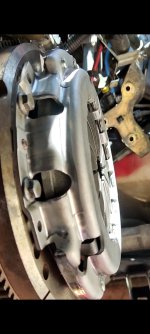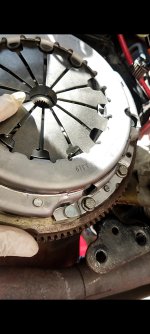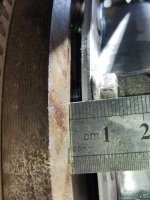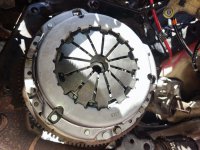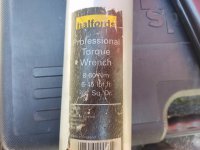You are using an out of date browser. It may not display this or other websites correctly.
You should upgrade or use an alternative browser.
You should upgrade or use an alternative browser.
Technical Clutch pedal not working after clutch replacement.
- Thread starter Jdazz
- Start date
Currently reading:
Technical Clutch pedal not working after clutch replacement.
In my opinion this isn't right on this carPressure plate bolted flush to the flywheel is flat as a pancake.
I try looking up the transmech part number. It only comes up with one hit
EuroCarParts
Look up their compatible cars and it's listing is wrong
It lists both
1.2 2004 panda
And
1.2 2010 panda
Which can't be right as the 2004 has a 180mm and the 2010 has a 200mm clutch
NoI'm I missing some washers
A 3mm gap is about right
There has to be some clamping force otherwise the drive plate would just spin
The transmech is 180mm, in fact all my clutch collection are 180.In my opinion this isn't right on this car
I try looking up the transmech part number. It only comes up with one hit
EuroCarParts
Look up their compatible cars and it's listing is wrong
It lists both
1.2 2004 panda
And
1.2 2010 panda
Which can't be right as the 2004 has a 180mm and the 2010 has a 200mm clutch
The thing is, it is just about finger tight. I fear it will come undone as the car is driven. Should the pressure plate not be flush against the flywheel?No
A 3mm gap is about right
There has to be some clamping force otherwise the drive plate would just spin
Yes 10Nm and flat to the flywheelThe thing is, it is just about finger tight. I fear it will come undone as the car is driven. Should the pressure plate not be flush against the flywheel?
It's spring loaded
The problem is the fingers shouldn't go flat
ridex and valeo both look like the correct part numbers to me
Yes 10Nm and flat to the flywheel
It's spring loaded
The problem is the fingers shouldn't go flat
Exactly!Yes 10Nm and flat to the flywheel
It's spring loaded
The problem is the fingers shouldn't go flat
They all behave the same way, even the original AP that was installed in the car.ridex and valeo both look like the correct part numbers to me
This does not read right it's ownNo
A 3mm gap is about right
There has to be some clamping force otherwise the drive plate would just spin
Pressure plate should not go all the way to the flywheel. Most small cars there is a gap of around 1.5 - 2 mm
Yours is around 3 - 3.5 mm which is close enough
The gap should close easy the 6 pressure bolts are only torqued to 10Nm
They all behave the same way, even the original AP that was installed in the carridex and valeo both look like the correct part numbers to me
I guess I'm gonna take a gamble and start reassembling everything leaving that gap.This does not read right it's own
Pressure plate should not go all the way to the flywheel. Most small cars there is a gap of around 1.5 - 2 mm
Yours is around 3 - 3.5 mm which is close enough
The gap should close easy the 6 pressure bolts are only torqued to 10Nm
I will let you know if it works.
Thanks
Not yet we should be able to sort this properly. No clamping pressure equals clutch slipThey all behave the same way, even the original AP that was installed in the car
I guess I'm gonna take a gamble and start reassembling everything leaving that gap.
I will let you know if it works.
Thanks
What's the surface of the flywheel like
I know its been asked on page one, but the flatter side of the drive plate needs to be against the flywheel.
I have a transmech fitted to mine for the last couple of years. Although the 200 mm version on a 69hp engine.
So the original clutch works, no broken slave cylinderHello,
The reason I am replacing the clutch is because it failed. Not much left of it. I installed the worn clutch today and tightened the bolts to 15Nm to see how that felt and although there was travel at the pedal, it is not as light as it was before removal.
CorrectI also noticed that when I put the worn clutch against the flywheel, the pressure plate sits flush against the flywheel. This is of course due to the friction plate being completely worn.
7mm is approx 3x too muchWhen I put the new clutch against the flywheel there is a gap of about 7mm between the pressure plate and the flywheel,
No point in carrying on lifting the gearbox up and down if the fingers are flattenedwhen I tighten the screws to 15Nm this gap is no more but the diagram spring compresses so much it looses its dome shape and becomes very stiff and there is no travel at the clutch pedal. I have already busted 2 slave cylinders out of frustration.
GreatThe plastic bit is present in the slave cylinder and there is no air on the line.
Pointless, no clamping pressure equals clutch slip, Very likely for a very big bang eventulyToday I installed the new clutch kit and very lightly tightened the pressure plate bolts by feel and using loctite. There was a gap of about 4mm between the pressure plate and the flywheel. I fear this will be my last try with this car and after spending money on clutches and lots of hours on labour I just can't think of what it could be.
I take it you mean if you fit the old drive plate with a new pressure plateI got the same result when I put the worn clutch and tighten the bolts all the way down.
What happens if you do it the other round, fit the new drive plate with the original pressure plate.I have compared the original pressure plate with the replacement I am hoping to use and they have the same measurements, same with the release bearings.
- Joined
- Sep 14, 2009
- Messages
- 19,899
- Points
- 3,413
The original pressure plate spring will have been over-stressed by the geometry of a worm friction plate. It's not unusual for spring fingers to fracture and get thrown around inside the bell-housing. Only reuse an old pressure plate if a good clutch was removed for some other reason.
I didn't say reuse the old preasure plateThe original pressure plate spring will have been over-stressed by the geometry of a worm friction plate. It's not unusual for spring fingers to fracture and get thrown around inside the bell-housing. Only reuse an old pressure plate if a good clutch was removed for some other reason.
We need to find the problem
There's only 3 parts it can be
Flywheel
Clutch pressure plate
Clutch drive plate
We know if we put the original parts back
It works
We know if we put the old drive plate with a new pressure it doesn't work (possibly)
Which leaves a good possibility of a miss match of the pressure plate
For the sake of 6 bolts I don't see a problem in temporarily testing it
Picture of the front of the flywheel would also be helpful
Good morning,Not yet we should be able to sort this properly. No clamping pressure equals clutch slip
What's the surface of the flywheel like
I know its been asked on page one, but the flatter side of the drive plate needs to be against the flywheel.
I have a transmech fitted to mine for the last couple of years. Although the 200 mm version on a 69hp engine.
"No clamping pressure equals clutch slip". Absolutely agree.
Hi,Not yet we should be able to sort this properly. No clamping pressure equals clutch slip
What's the surface of the flywheel like
I know its been asked on page one, but the flatter side of the drive plate needs to be against the flywheel.
I have a transmech fitted to mine for the last couple of years. Although the 200 mm version on a 69hp engine.
"No clamping pressure equals clutch slip"
Absolutely agree.
I have always put the flatter side of the friction plate against the flywheel.
The original fiat (AP) and all the spares I've got are 180mm.
With the original clutch there is also no clutch pedal travel if the pressure plate bolts are tightened to 10 or even 8Nm, maybe my torque wrench is not sensitive enough to its lower settings.So the original clutch works, no broken slave cylinder
Correct
7mm is approx 3x too much
No point in carrying on lifting the gearbox up and down if the fingers are flattened
Great
Pointless, no clamping pressure equals clutch slip, Very likely for a very big bang eventuly
I take it you mean if you fit the old drive plate with a new pressure plate
What happens if you do it the other round, fit the new drive plate with the original pressure plate.
I have tried all sort of combinations; old pressure plate and new friction plate, new pressure plate and old friction plate, old pressure plate with old friction plate, new pressure plate with new friction plate and as long as the pressure plate is flat against the flywheel and here is no clutch disengagement, the only thing I've just now noticed is the the spring diaphragm was getting so loaded by bolting it down to torque spec. I decided to undo the bolts so as to regain the original shape of the spring diaphragm and with this I have got some clutch pedal travel back but don't know yet if it will be enough to disengage the clutch and go through the gears. The other thing is that with the pressure plate not being bolted all the way down it may came loose with a big bang and that is definitely something I want to avoid.
Attachments
Similar threads
- Replies
- 42
- Views
- 2K


